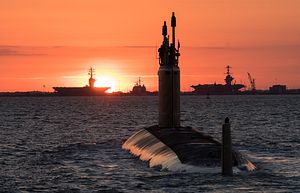The U.S. Navy took delivery of the Virginia-class nuclear attack submarine USS Washington (SSN-787), the 14th sub of the Virginia-class sub, on May 26, the service said in a statement.
As I reported previously (See: “US Navy’s Latest Nuclear Attack Submarine Completes Sea Trials”), the USS Washington successfully completed initial sea trials off the coast of Virginia in early April.
According to a May 27 U.S. Navy press release, it completed the so-called Board of Inspection and Survey trials at the beginning of May receiving a score of 96 out of 100, “the highest score to date on any new construction Virginia-class submarine.”
The U.S. Navy’s latest nuclear attack submarine is the fourth of eight Virginia-class Block III submarines. (Virginia-class boats are built in block increments, with Block I and Block II already delivered to the U.S. Navy.)
Block III boats are fitted with the so-called Virginia Payload Modules (VPM) – larger tubes that increase the ship’s missile-firing payload possibilities (See: “US Subs Getting Fire Power Boost”). As I explained elsewhere:
While the first 10 Block I and Block II Virginia-class submarines feature 12 individual 21-inch diameter vertical launch tubes able to fire Tomahawk Land Attack Missiles (TLAMS), “the Block III submarines are built with two-larger 87-inch diameter tubes able to house six TLAMS each,” according to the U.S. Navy website. The new 87-inch tubes have been designed to accommodate future missile systems in addition to the Tomahawk.
In addition, Virginia-class Block III boats are equipped with four torpedo tubes for MK48 torpedoes. Furthermore, next to a redesigned bow, Block III Virginia-class boats also contain “a water-backed Large Aperture Bow (LAB) sonar array that replaces the air-backed sonar sphere found in the first 10 Virginias.” This, in combination with the its so-called fly-by-wire capability, enables the boat to perform important intelligence and surveillance missions.
The Virginia-class is designed for operation in the world’s littoral and deep waters. The boats are multipurpose platforms designed “to fulfill the seven core competencies of the U.S. Navy’s submarine force: anti-submarine warfare; anti-surface warfare; delivery of special operations forces; strike warfare; irregular warfare; intelligence, surveillance and reconnaissance; and mine warfare,” I reported elsewhere.
Construction of the USS Washington began in September 2011. The sub is expected to be commissioned this summer in Norfolk, Virginia. A second Virginia-class sub, the USS Colorado, is slated to be commissioned in the fall. The U.S. Navy is planning to acquire up to 51 boats of the class in the coming decades.
The U.S. Navy will commission seven additional warships this year including the long-delayed nuclear-powered Gerald R. Ford-class aircraft carrier USS Gerald R. Ford in 2017. Other ships include the Independence-class Littoral Combat Ship (LCS) USS Gabrielle Giffords and USS Omaha; the Freedom-class LCS USS Sioux City and USS Little Rock; the Arleigh Burke-class destroyers USS Rafael Peralta and USS John Finn.
































